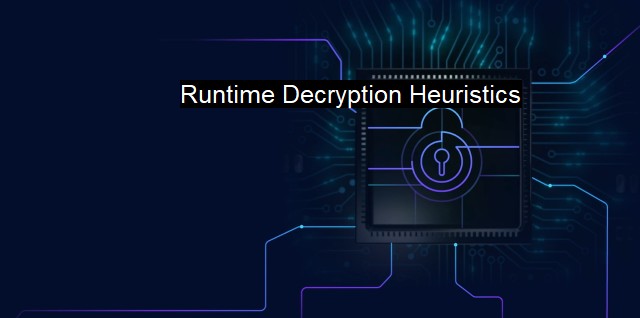What are Runtime Decryption Heuristics?
Uncovering Cybersecurity Threats: How Runtime Decryption Heuristics Stops Malware in Its Tracks
Runtime decryption heuristics are techniques used in the cybersecurity and antivirus context to decipher encrypted malicious codes contained in files or programs without necessarily having the exact decryption key. The term runtime refers to the period during which a program is executing its code. It is during this period that a lot of crucial activities happen, such as processing user input, displaying output, and interacting with system resources or hardware.Encryption is often a technique used by hackers to conceal harmful software or data from being detected by security measures in systems. They envelop malicious software with layers of encryption to make it undetectable, or at least unrecognizable, to basic security scanning tools. Runtime decryption heuristics comes to play here as a method to decrypt these encrypted programming codes and expose their true nature.
How do runtime decryption heuristics work? A heuristic engine runs a kind of code emulation, where a suspicious application's behaviors can be monitored in a controlled environment before affecting the operating system. Every line of the code is trailed and recorded. The code is let to run until it decrypts itself. As a result, the actual malicious sequences hidden behind the encryption layers are exposed, documented, and quarantined or purged before it harms the system.
This approach provides multiple advantages when compared to traditional static analysis techniques, where the code is analyzed line by line without taking its runtime behavior into account. It can identify new or modified versions of known malware, even if it uses advanced code obfuscation techniques to avoid detection. Runtime decryption heuristics can improve both the detection accuracy and speed, making it a valuable tool for modern antimalware solutions.
Although runtime decryption heuristics are favorable for a more proactive and successful malware detection approach, they come with their own sets of drawbacks. First is the false positives issue. As heuristic analysis learns and builds recognition based on patterns and behaviors, it becomes prone to alarm false positives where benign codes could be signaled as falsely malicious.
Second, runtime heuristics requires a significant amount of computational resources. Emulating codes and tracking behaviors signify heavy processing procedures that might slow down the system's performance. As such, businesses using this technique need to strike a balance between system speed and security.
Though the drawbacks are notable, the benefits and potential to increase the effectiveness of malware detection are immense. Using runtime decryption heuristics wouldn't eliminate the need for conventional techniques; instead, it becomes an additional layer defending against the ever-evolving threats.
Runtime decryption heuristics is about using methods of inference, pattern recognition, and behavior tracking to identify and unveil encrypted malware in a program at runtime. The decryption part here doesn't necessarily actually decrypt an encryption layer but instead focuses on analyzing the behavior of a code till the harmful sequences expose themselves. Despite their drawbacks, when coupled with traditional antivirus measures, runtime decryption heuristic techniques can significantly enhance data security and consider an essential component in a robust cybersecurity strategy.

Runtime Decryption Heuristics FAQs
What are runtime decryption heuristics?
Runtime decryption heuristics are techniques used by antivirus software to monitor a running program's behavior and detect if it is using encryption or decryption functions to hide malicious code.How do runtime decryption heuristics work?
Runtime decryption heuristics work by analyzing the memory and processes of a running program, looking for patterns and behaviors that indicate it may be using encryption or decryption functions. If suspicious behavior is detected, the antivirus software can take action to prevent the malicious code from executing.Are runtime decryption heuristics effective against all types of malware?
While runtime decryption heuristics can be effective against many types of malware, they may not be effective against all forms of sophisticated, advanced malware that are designed to evade detection. It is important to use multiple layers of cybersecurity protection to minimize the risk of infection.Are there any potential downsides to using runtime decryption heuristics?
There can be potential downsides to using runtime decryption heuristics, such as false positives, where legitimate programs are flagged as malicious. This can cause disruptions to normal operations and may require manual intervention to resolve. It is important to carefully configure and customize the antivirus software to minimize these risks.| | A | | | B | | | C | | | D | | | E | | | F | | | G | | | H | | | I | | | J | | | K | | | L | | | M | |
| | N | | | O | | | P | | | Q | | | R | | | S | | | T | | | U | | | V | | | W | | | X | | | Y | | | Z | |
| | 1 | | | 2 | | | 3 | | | 4 | | | 7 | | | 8 | | |||||||